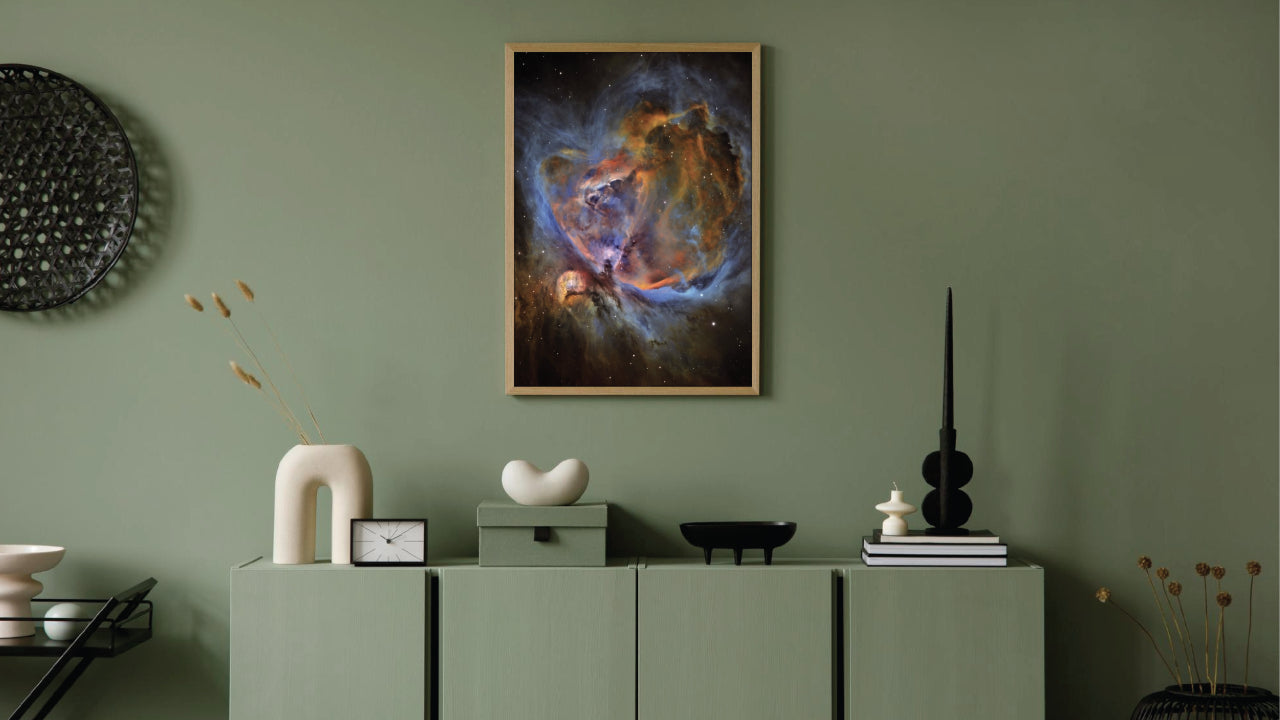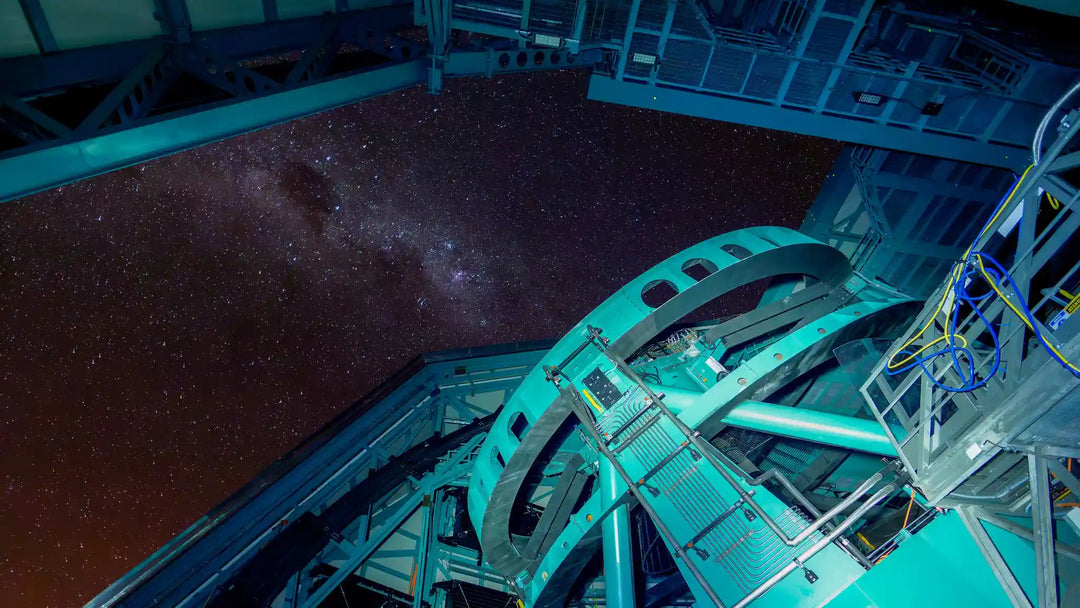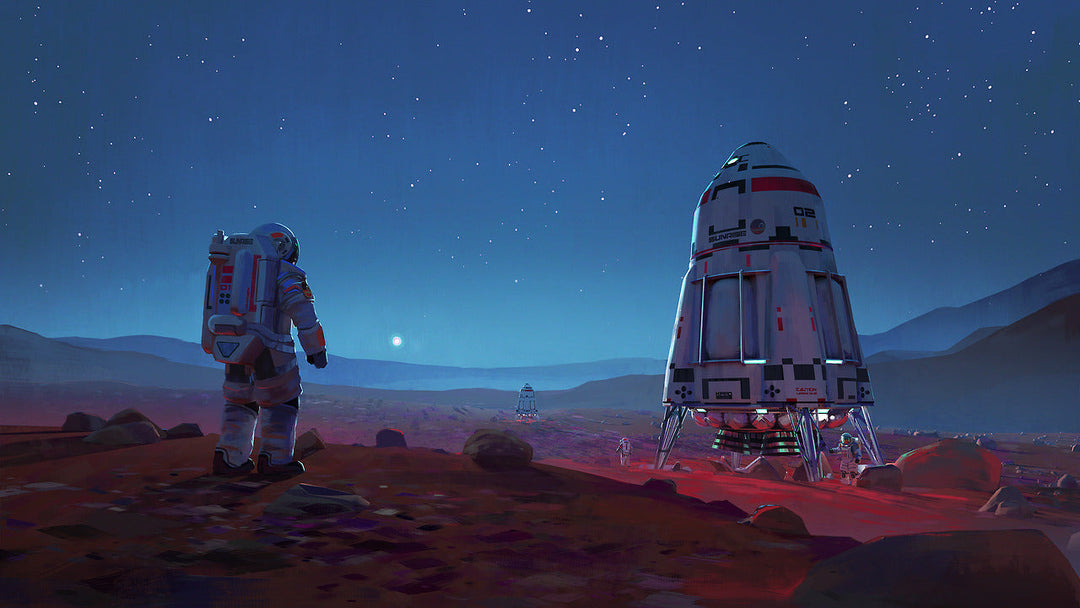The Price of Authenticity: Why Deep Space Images Resist Perfect Clarity (And Why That’s Part of Their Magic)

Hi, I’m Adam Jesionkiewicz—founder of Astrography, creator of many of the deep space images in our collection, and an obsessive astrophotographer who’s spent decades chasing photons across the cosmos. I’ve lost count of the nights I’ve spent glued to telescopes, cameras, and enough coffee to fuel a small observatory, all to capture the universe’s faintest whispers.
One question I get asked more than any other? “Why don’t these deep-space photos look as razor-sharp as my smartphone’s vacation shots?”
The answer lies in a cocktail of physics, Earth’s fickle atmosphere, and the beautiful, maddening challenge of photographing objects older than time itself.
Let’s unpack this.
Deep Space Images: The Atmosphere - Nature’s Blurry Lens
Imagine trying to take a photo of a coin at the bottom of a swimming pool while someone’s splashing waves into it. That’s what astronomers deal with daily. Earth’s atmosphere isn’t just air—it’s a turbulent, shimmering ocean of gases. This turbulence, called astronomical seeing, blurs light from stars and galaxies.
Even on a “clear” night, the atmosphere limits how much detail we can resolve. Most ground-based telescopes can’t see finer than 2–3 arcseconds (a unit of angular size—picture a grain of sand held at arm’s length). To put this in perspective: the Moon is 1,800 arcseconds wide.
That’s why astrophotographers chase altitude and isolation. They haul gear to deserts in Chile, peaks in Hawaii, or remote sites in Namibia—places with thin, stable air and minimal light pollution. But even there, the atmosphere’s fingerprint remains. It’s like trying to read a book through fogged-up glasses.
Deep Space Photos: The Data Isn’t Infinite
Every astro-image starts with photons that traveled millions (or billions) of years to hit our sensors (deep space images too). But here’s the catch: the universe doesn’t send us a high-res JPEG. Cameras collect raw, grainy data, and we stretch, stack, and sharpen it to reveal hidden structures.
However, there’s a hard limit to how much detail exists in that data. Enlarging a galaxy to fit a 1-meter print won’t magically add new stars—it’ll just stretch the existing pixels. Think of it like zooming in on a vintage newspaper photo: the ink dots get bigger, but the story stays the same.
This is why some images are mosaics. Stitching dozens of shots together gives a wider field of view, but it doesn’t increase the resolution of individual details. To capture finer features, you’d need a telescope with a focal length longer than a giraffe’s neck (3+ meters!). And even then, atmospheric blur often wins.
When Sharpness Is Possible: The Exception to the Rule
Now, you might be thinking: “But wait—your ‘Big Moon’ print is insanely sharp! And what about the Gigapixel Milky Way collection?”
You’re absolutely right. Those pieces are razor-sharp—but here’s the twist: they’re not Deep Space images.
The Moon is our cosmic neighbor—a giant glowing marble just 1.3 light-seconds away. Capturing its craters is like photographing a mountain on the horizon; it’s close enough to dodge the worst of atmospheric distortion. Similarly, our Gigapixel works are ultra-high-resolution mosaics of wide-field targets like the Milky Way. These are like stitching together a sprawling landscape photo—each tile adds breadth, but the subject itself isn’t a tiny, distant galaxy fighting against physics.
Deep Space is different. When your subject is a nebula 2,000 light-years away or a galaxy a billion light-years distant, even the best gear hits a wall. The photons are sparse, the angular size is minuscule, and the atmosphere? It’s the ultimate party crasher.
The Nuclear Option: Escape the Atmosphere
Want to beat the atmosphere? Simple: leave it. Space telescopes like Hubble or JWST orbit above Earth’s blur, delivering razor-sharp views of the cosmos. But let’s be real—most of us aren’t NASA.
Ground-based astrophotography is a dance with imperfection. We push technology to its limits (adaptive optics, multi-hour exposures), but we’re still bound by physics. When you see a slightly “soft” print from us, remember: you’re looking at the universe through a keyhole .
Deep Space Images: Why We Don’t “Invent” Pixels
Some ask: “Why not Photoshop in more detail?” For us, that’s a line we won’t cross.
Every pixel in our prints represents real photons from real cosmic objects.
Adding fake details would betray the science—and the awe—behind these images.
Yes, a nebula might look smoother on your screen, but enlarging it to wall art size exposes the truth: space is messy, distant, and defiantly real.
Deep Space Imagery: The Art of Embracing Limits
Astrophotography is the most humbling form of photography.
It’s not about control—it’s about collaboration. We collaborate with the atmosphere, the laws of optics, and the faint glow of objects older than Earth itself. A print that looks slightly pixelated up close isn’t a flaw; it’s a badge of honesty. It whispers: “This is as close as humanity can get… for now.”
When you hang one of our pieces, you’re not just decorating a wall. You’re framing a moment of cosmic archaeology—a snapshot of light that began its journey before humans existed.
The blur? That’s the universe saying, “You’ll need to work harder to see my secrets.”
In summary...
Astrophotography is the ultimate art form—a stellar blend of science, deep expertise, skill, talent, and creativity. It demands sacrifices, dedication, and a whole lot of grit. Astrophotographers aren’t just hobbyists or craftsmen; they're the visionary artists of our time. I hope this gives you a new appreciation for the tremendous work they put in to open a window on the cosmos for all of us.
It’s not about razor-sharp clarity or perfect photo quality – it’s the cosmic stories they reveal that truly matter.
Please, remember about...
Cosmic Challenges: Earth's turbulent atmosphere blurs deep-space images, making astrophotography a battle against natural limits.
Data Reality: Photographs capture raw, pixel-limited cosmic data—no amount of digital magic can add photons that aren’t there.
The Art of Technique: Astrophotographers mitigate these challenges through long exposures, stacking images, and choosing optimal, high-altitude locations.
Authentic Cosmic Storytelling: Every pixel is genuine, representing real cosmic moments, reflecting not flaws but the honest beauty and limits of our universe.
PS: Next time you’re face-to-face with one of our prints, take a step back. The farther you stand, the sharper it gets—a metaphor, I think, for how we explore the cosmos: patience, perspective, and a little faith in the Unseen.
— Adam Jesionkiewicz
Founder, Astrography
P.P.S. If you’re craving that “wow” factor of ultra-sharp detail, check out our Big Moon or Gigapixel collections. They’re proof that sometimes, the universe does play nice—just don’t ask it to do the same for a galaxy a billion light-years away. 😉 Just take a look at the image below. ⤵️
FAQ Section - You Ask, We Answer
What causes blurriness in deep-space images?
Blurriness in deep space images is primarily caused by atmospheric turbulence, which distorts the light from stars and celestial objects as it passes through Earth's atmosphere. This phenomenon, known as astronomical seeing, leads to fluctuations in the light's intensity and sharpness, resulting in blurred images.
How does astronomical seeing affect telescope observations?
Astronomical seeing can severely limit the resolution of ground-based telescopes. The turbulence in the atmosphere can cause light waves to scatter, leading to a degradation of image quality. For most observations, this results in a resolution limit of around 2–3 arcseconds, which affects how clearly details can be captured.
Why are some space images sharper than others?
Sharpness in astrophotographs can vary based on several factors, including atmospheric conditions, the quality of the telescope optics, and the imaging techniques used. Images of nearby celestial bodies like the Moon tend to be sharper due to reduced atmospheric distortion compared to distant objects like galaxies or nebulae.
What techniques do astrophotographers use to enhance image quality?
Astrophotographers often use techniques such as stacking multiple images to improve detail and reduce noise. They may also employ deconvolution methods during post-processing to sharpen images and reveal hidden structures. Additionally, using high-quality optics and capturing images from stable locations helps enhance overall image quality.
How do space telescopes like Hubble or JWST achieve clearer images?
Space telescopes like Hubble operate above Earth’s atmosphere, eliminating atmospheric distortion entirely. This allows for longer exposure times without blurring effects, resulting in incredibly detailed images of distant celestial objects. The large mirrors used in these telescopes also contribute to their ability to capture high-resolution images.
Why is authenticity important in astrophotography?
Authenticity is crucial in astrophotography because it ensures that each image represents real photons captured from cosmic phenomena. Altering images digitally can misrepresent scientific data and diminish the awe and wonder that comes from observing the universe as it truly is.
Can digital enhancements improve deep-space photographs?
While some digital enhancements can help improve clarity, such as sharpening or noise reduction techniques, these methods mustn't introduce artificial details that were not present in the original data. Maintaining authenticity while enhancing an image is a delicate balance for astrophotographers.
How does light pollution impact deep-space imaging?
Light pollution significantly hampers deep-space imaging by obscuring faint celestial objects and reducing contrast in images. Astrophotographers often seek dark sky locations or use special filters to minimize the effects of artificial light on their observations.
Why is patience important in astrophotography?
Patience is vital in astrophotography because capturing high-quality images often requires long exposure and careful attention to detail during setup and processing. Additionally, conditions can change rapidly; waiting for clear skies or optimal atmospheric conditions can significantly affect the final image quality.













![Vera C. Rubin Observatory: Revolutionizing Astronomy Through the World's Most Advanced Telescope [All You Need To Know]](http://astrography.com/cdn/shop/articles/vera-c.-rubin-observatory_main.webp?v=1751627507&width=1080)

Leave a comment